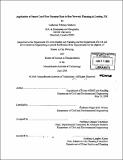Application of Smart Card fare payment data to bus network planning in London, UK
Author(s)
Seaborn, Catherine Whitney
DownloadFull printable version (33.13Mb)
Other Contributors
Massachusetts Institute of Technology. Dept. of Civil and Environmental Engineering.
Advisor
Nigel H.M. Wilson.
Terms of use
Metadata
Show full item recordAbstract
This research contributes to an emerging body of literature on the application of smart card data to public transportation planning. It also addresses interchange planning, a key component of public transportation network planning that has lately received renewed interest as evidenced by planning literature on integrated and intermodal networks. The research objective of assessing the potential application of smart card data to bus network planning is met, first, by a review of existing data systems and the bus network planning approach at Transport for London (TfL). Then, three potential interchange combinations: bus-to underground, Underground-to-bus, and bus-to-bus are examined to gain an understanding of interchange behavior in London and to formulate recommendations for elapsed time thresholds to identify interchanges between journey stages for each passenger on the TfL network. Other TfL data are compared with the results of linking journey stages into complete journeys based on these elapsed time thresholds. Finally, the complete journey data are applied to bus network planning case studies that illustrate the value of new contextual and quantitative information that would be available to network planners using smart card data without necessitating additional data from other sources such as Automated Vehicle Locators or Automated Passenger Counters. (cont) Recommended elapsed time thresholds for identifying interchanges across the London network are: 20 minutes for Underground-to-bus interchanges, 35 minutes for bus-to underground interchanges, and 45 minutes for bus-to-bus interchanges, but a range of values that account for variability across the network are provided. Key findings about intermodal travel behavior in London include evidence of complex bus travel patterns during the Midday and PM Peak time periods and of land uses near Underground stations influencing interchange behavior. Moreover, complete journey data result in approximately 2.3 daily public transportation journeys per passenger, 1.3 journey stages per public transportation journey, and 25 percent of Underground journeys including a linked bus journey stage. Finally, examples of new contextual information for bus network planning include connectivity of bus routes, intermodality of bus journeys, duration of bus access journeys, and duration of Underground to-bus interchanges. New quantitative information about the number of passengers transferring between two bus routes can be used in cost-benefit analyses of service changes to the bus network.
Description
Thesis (M.C.P.)--Massachusetts Institute of Technology, Dept. of Urban Studies and Planning; and, (S.M. in Transportation)--Massachusetts Institute of Technology, Dept. of Civil and Environmental Engineering, 2008. Includes bibliographical references (p. 131-133).
Date issued
2008Department
Massachusetts Institute of Technology. Department of Civil and Environmental Engineering; Massachusetts Institute of Technology. Department of Urban Studies and PlanningPublisher
Massachusetts Institute of Technology
Keywords
Urban Studies and Planning., Civil and Environmental Engineering.